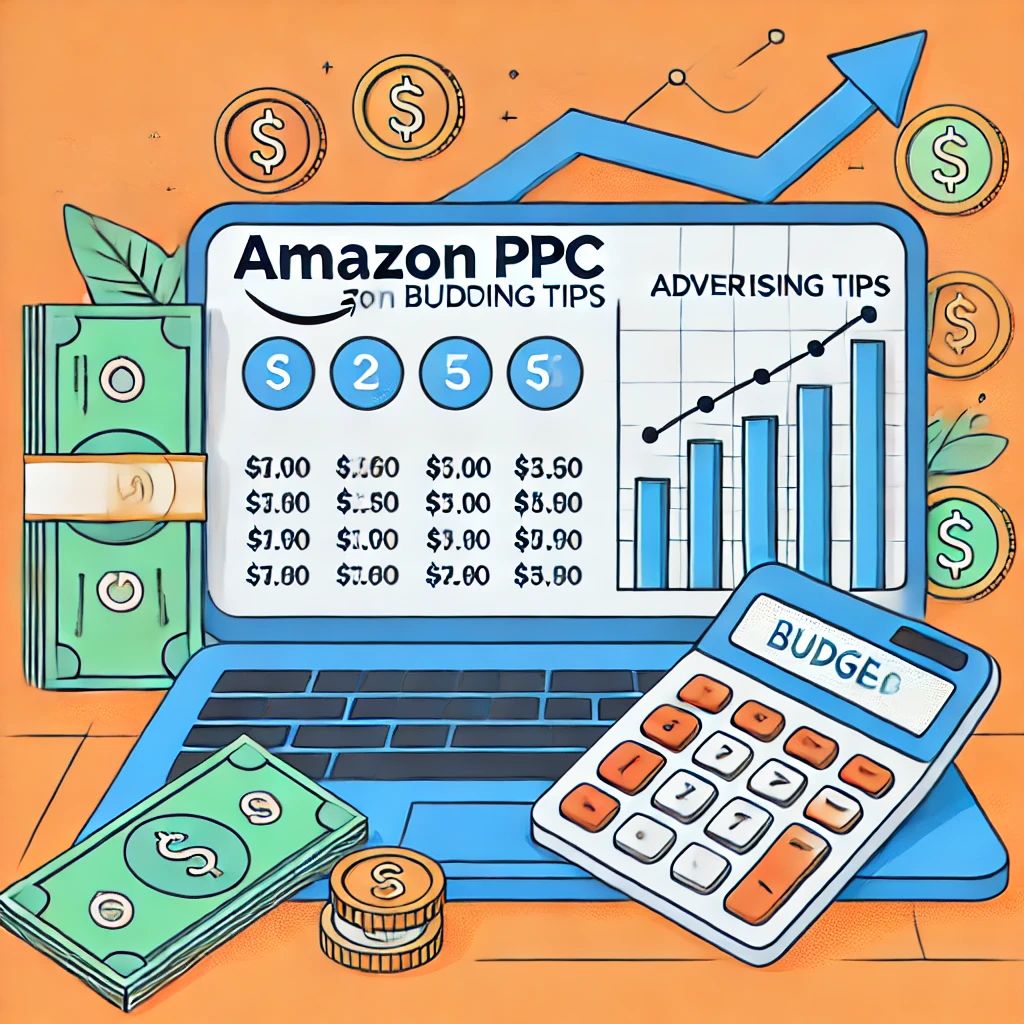TL;DR:
- Know your margins before setting a budget. Spending blindly without profit calculations is a mistake.
- ACOS vs. TACOS matters. Track both to ensure ad spending fuels growth, not just short-term sales.
- Spread your budget wisely across campaigns. Sponsored Products, Brands, and Displays all serve different goals.
- Stop wasting money on broad targeting. Focus on high-converting keywords that drive sales.
- Use dayparting to cut dead-weight ad spend. Ads don’t need to run 24/7 if buyers aren’t converting.
- Amazon wants you to spend—smart sellers optimize. Every pound should bring a return, not just impressions.
Amazon PPC in 2025 isn’t just about setting a budget and hoping for the best—it’s about spending smart, not just spending more. With CPCs rising, competition getting fiercer, and Amazon constantly tweaking its ad algorithms, UK sellers need to stay sharp or risk watching their profits disappear into ad spend black holes.
The reality? A bigger budget doesn’t guarantee better results. It’s not about how much you spend—it’s about how well you allocate it. Are you bidding on the right keywords? Are you overpaying for clicks that don’t convert? Are you balancing your ad spend between brand awareness and actual sales?
If you’re tired of throwing money at Amazon ads and not seeing the returns you expect, this blog is for you. We’re breaking down practical, data-driven PPC budgeting tips that will help UK sellers maximize their ad spend, control costs, and make Amazon advertising work for them—not the other way around.
Quick guide:
- #1: Set a clear PPC budget based on your profit margins
- #2: Understand the difference between ACOS and TACOS
- #3: Allocate budget strategically across campaign types
- #4: Prioritize high-converting keywords over broad targeting
- #5: Use dayparting to avoid wasting ad spend
- #6: Leverage negative keywords to cut unnecessary costs
- #7: Balance between automated and manual campaigns
- #8: Monitor bid adjustments to control CPC inflation
- #9: Test and refine your ad creatives for better CTR
- #10: Reinvest profits into top-performing campaigns
#1: Set a clear PPC budget based on your profit margins
Let’s get one thing straight—if you don’t know your numbers, Amazon will happily take your money and leave you guessing where it went.
A solid PPC budget isn’t about throwing cash at ads and hoping for sales. It’s about understanding your profit margins and working backward. If your product sells for £50, but after Amazon fees, shipping, and costs you only pocket £20, then blindly spending £10 per click isn’t a strategy—it’s a fast track to losing money.
Here’s how UK sellers need to think about PPC budgeting:
- Know your breakeven ACOS – If your margin is 40%, you can’t afford to run ads at 50% ACOS and expect profits to magically appear.
- Decide how much you can reinvest – Are you aiming for aggressive growth, or do you need to stay profitable from day one? Your budget depends on your long-term strategy.
- Don’t overspend just to “win” placements – Amazon’s auction system rewards big spenders, but big spending doesn’t always mean big profits.
The sellers who win in 2025 aren’t just spending more—they’re spending smarter. Before setting any budget, crunch your numbers, know your limits, and make sure every pound spent has a plan behind it. Because guess what? Amazon isn’t handing out refunds if you overspend.
#2: Understand the difference between ACOS and TACOS
If you’re only looking at ACOS when managing your Amazon PPC budget, you’re playing checkers while your competitors are playing chess.
Let’s break it down:
- ACOS (Advertising Cost of Sales) tells you how much you’re spending on ads relative to the sales generated from those ads. It’s great for measuring PPC performance in isolation, but it doesn’t tell you the full story.
- TACOS (Total Advertising Cost of Sales) looks at your ad spend relative to your total revenue, including organic sales. This is what matters because the goal of PPC isn’t just to make ad-driven sales—it’s to boost overall business growth.
Here’s why UK sellers need to stop obsessing over ACOS alone:
- A low ACOS isn’t always good—it might mean you’re playing it too safe and missing growth opportunities.
- A high ACOS isn’t always bad—if it’s fueling organic sales and long-term ranking, it could be worth it.
TACOS shows if your ad spend is leading to a stronger brand presence, repeat customers and a sustainable Amazon business.
The trick? Use both. Watch ACOS to keep individual campaigns profitable, but track TACOS to ensure your overall business isn’t bleeding money on ads. Because in 2025, smart sellers aren’t just focused on PPC performance—they’re playing the long
#3: Allocate budget strategically across campaign types
If you’re dumping all your ad budget into one campaign type and hoping for the best, you’re doing Amazon’s job for them. Smart sellers diversify—because different campaigns serve different purposes, and knowing where to put your money is what separates profitable sellers from those constantly refilling their ad budgets with zero return.
Here’s how to think about it:
- Sponsored Products – Your bread and butter. These drive direct sales and should take up the majority of your budget, especially for high-converting keywords.
- Sponsored Brands – Great for building brand presence, especially if you want to drive traffic to your Amazon storefront instead of just a single product page.
- Sponsored Display – Retargeting gold. If you’re not using this to bring back potential buyers who viewed your product but didn’t purchase, you’re leaving money on the table.
How do you split your budget?
- 60-70% on Sponsored Products (because sales matter first)
- 20-30% on Sponsored Brands (to increase brand awareness and upsell)
- 10-15% on Sponsored Display (to bring back lost shoppers and increase repeat purchases)
Adjust based on what’s working—but never blindly throw money at everything. Amazon will happily let you spend more than necessary if you’re not tracking your numbers. Smart PPC isn’t just about spending more—it’s about knowing where every penny is going.
#4: Prioritize high-converting keywords over broad targeting
Amazon will gladly let you burn through your ad budget on broad, generic keywords that barely convert. But if you want profitable PPC campaigns, it’s time to get laser-focused on keywords that drive sales.
Here’s the problem with broad targeting:
- You pay for a ton of irrelevant clicks from shoppers who aren’t ready to buy.
- Your ads show up for vague searches where competition is brutal (think “running shoes” instead of “women’s waterproof running shoes”).
- You waste budget figuring out what works, instead of investing in what already does.
Instead, double down on high-converting keywords—these are the search terms that:
- Have a proven track record of driving conversions.
- Are specific to your product (long-tail keywords = better buyer intent).
- Give you a higher return on ad spend without inflating your CPC unnecessarily.
How do you find them? Data. Look at your Search Term Report, identify which keywords are consistently bringing in sales, and shift more of your budget toward them.
The bottom line? Stop trying to be everywhere. Broad targeting is Amazon’s way of making sure you spend more—but smart sellers invest where the money comes back.
#5: Use dayparting to avoid wasting ad spend
If your ads are running 24/7, you’re probably paying for clicks when no one’s buying. That’s where dayparting comes in—aka only running your ads during peak buying hours so your budget isn’t wasted on window shoppers.
Here’s why this matters:
- Not all hours of the day are equal. Some hours drive tons of clicks but few conversions (think late-night browsing but no buying).
- CPCs can spike during peak hours, so knowing when to bid aggressively and when to pull back can save your budget.
- Some products sell better during specific time frames—if you’re selling office supplies, running ads at 3 AM isn’t exactly strategic.
How do you use dayparting effectively?
- Analyze your data – Check your Advertising Reports to see when your sales peak and when conversions drop.
- Adjust your bids by time of day – Bid higher when your audience is most active, and lower (or pause) when they’re just browsing.
- Test and refine – Don’t assume one schedule fits all. Track performance, tweak your strategy, and cut dead-weight hours.
Amazon wants you to run ads all day—it makes them more money. But smart sellers? They spend when it counts.
#6: Leverage negative keywords to cut unnecessary costs
If you’re not using negative keywords, you’re paying for clicks that never convert—and Amazon couldn’t be happier about it. Every time someone clicks your ad on a irrelevant search term, that’s your money down the drain.
Understand that Amazon keyword research isn’t just about finding the right keywords—it’s about blocking the wrong ones.
Why negative keywords matter:
- They prevent wasteful spending – If you sell premium leather handbags, you don’t want to pay for clicks on “cheap handbags” or “faux leather purses.”
- They improve conversion rates – The more relevant your traffic, the more likely those clicks turn into actual sales.
- They help control ACOS – Fewer wasted clicks = better efficiency = lower advertising costs.
How to use them:
- Check your Search Term Report – Find irrelevant searches that are eating your budget.
- Add them as negative keywords – Block anything that isn’t relevant to your product or buyer intent.
- Keep updating – Amazon keyword research isn’t a one-time thing. New wasted keywords pop up all the time—stay on top of them.
Amazon wants you to cast a wide net. But if you’re not actively cutting out bad traffic, you’re just paying to educate shoppers who will never buy. Be ruthless. Your budget depends on it.
#7: Balance between automated and manual campaigns
Relying only on Amazon’s automated campaigns is like letting a self-driving car go full speed with no brakes—you might get somewhere, but at what cost? On the other hand, going 100% manual means spending hours tweaking bids and chasing performance data. The real winners? They find the perfect balance.
This is where Amazon Sponsored Products management comes in. If you’re not structuring your campaigns properly, you’re either leaving money on the table or burning through your budget faster than you can scale.
Here’s the strategy:
- Use auto campaigns for discovery – Let Amazon test which keywords and ASINs work best. But don’t just set and forget—mine that data for high-converting terms.
- Use manual campaigns for control – Once you identify what’s working, shift the budget into manual campaigns to fine-tune bids, placements, and targeting.
- Regularly move performing search terms – Take converting keywords from auto campaigns and plug them into manual campaigns with exact match targeting.
The mistake most sellers make? Letting Amazon decide their ad spend without oversight. Automated campaigns can be great for data, but real profits come from the control that manual campaigns give you.
Amazon wants you to trust its system blindly—but smart sellers use automation as a tool, not a crutch.
#8: Monitor bid adjustments to control CPC inflation
If you’re not actively watching your bids, Amazon will happily help you spend more than necessary. CPC inflation is real, and in 2025, bidding blindly is a guaranteed way to lose money.
Here’s what’s driving CPCs up:
- More competition – More sellers, more aggressive bidding, and more deep-pocketed brands mean CPCs are rising across the board.
- Amazon’s AI-driven bidding – “Suggested” bid increases aren’t always in your best interest—they’re designed to keep you spending.
- Bid wars that drain budgets fast – If you keep upping your bids just to outdo competitors, you might win the ad spot—but at what cost?
How to keep CPCs in check:
- Set bid caps – If you don’t cap bids, Amazon will keep pushing them higher, often unnecessarily.
- Use placement adjustments wisely – Top-of-search placements are great, but only if they convert at a profitable rate.
- Optimize bids based on performance, not emotion – Don’t get caught in bidding wars. If a keyword is too expensive, find alternative, high-converting terms.
Amazon wants sellers to chase higher bids, but smart advertisers play defense. If you’re not monitoring and adjusting regularly, your PPC budget isn’t working for you—it’s working for Amazon.
#9: Test and refine your ad creatives for better CTR
Amazon PPC isn’t just about who bids the most—it’s about who gets the click. If your ad creatives are boring, generic, or just plain forgettable, you’re paying for impressions that lead nowhere.
Here’s the fix: test, refine, and optimize. The best PPC campaigns aren’t set in stone—they evolve based on what gets shoppers to stop, click, and buy.
What makes a winning ad creative?
- High-quality product images – If your main image doesn’t pop, don’t expect shoppers to stop scrolling.
- Amazon infographic images – These are gold for PPC ads. A strong infographic highlights key benefits in seconds, making your product stand out instantly.
- Short, compelling copy – Keep it clear, benefit-driven, and customer-focused—no one cares about your brand story if they can’t tell why your product is better.
- A/B testing – Always test different images, infographics, and ad variations to see what improves CTR.
Amazon wants you to believe high bids alone win placements—but the truth is, that better creatives mean lower CPCs and higher conversions. So before you throw more money at ads, ask yourself: Is your ad worth clicking?
#10: Reinvest profits into top-performing campaigns
A well-optimized PPC strategy isn’t just about cutting wasted spend—it’s also about knowing where to reinvest for maximum returns. If certain campaigns are consistently driving profitable sales, scaling them strategically can help you grow without inflating your ACOS.
Here’s how to make the most of your ad budget:
- Double down on high-converting campaigns – Look at the numbers. If a campaign delivers strong results, a controlled budget increase can help you capture even more sales.
- Optimize as you scale – Just because an ad is working now doesn’t mean it will always perform the same. Continuous adjustments to bids, creatives, and audience targeting keep it efficient.
- Test smarter, not wider – Instead of launching too many new campaigns, refine what’s already working. Small tweaks can make a big impact without unnecessary risk.
For sellers looking to refine their approach, leveraging Amazon advertising services focusing on optimization rather than just spending can be the key to sustainable growth. Scaling isn’t about spending more—it’s about spending smarter.
See you next week!
Amazon’s ad system is designed to keep you spending. The “recommended” bids, the endless new ad placements, and the AI-driven automation are all there to ensure your budget works for Amazon first, and for you only if you know how to play the game.
That’s why the most successful sellers don’t just run ads—they run them with purpose. They track every penny, cut out wasted spend, and reinvest in what moves the needle. And when they need expert insights to scale without burning through cash? They turn to Amazon consultants who know exactly where to optimize and where to pull back.
Because in 2025, Amazon PPC isn’t about who spends the most—it’s about who spends it best.










About The Author
Glyn Jones
Glyn Jones is a Director at eStore Factory, an Amazon SPN certified agency that offers an extensive range of solutions for businesses looking to strengthen their presence on Amazon. His experience as a former Amazon seller has given him a comprehensive understanding of the challenges that sellers face on the platform. Glyn is committed to sharing his expertise and insights to help others succeed in the competitive world of e-commerce. He is a valuable resource for sellers wanting to grow and establish their business on Amazon.